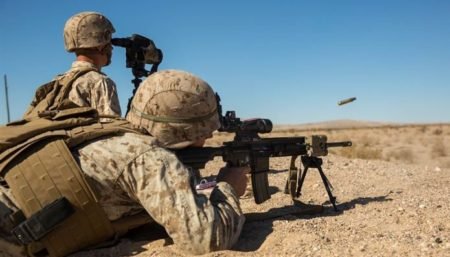
Recently our friends at TheFirearmBlog reported on the possibility of the United States Marine Corps selecting the HK 416 as their new service rifle. This was after Military.com reported U.S. Marines testing the HK 416 at the Air-Ground Combat Center in Twenty-Nine Palms, California under the designation of M27 IAR (Infantry Automatic Rifle).
The Marines, like the rest of the U.S. Military have been going through what seems to be a perpetual selection process for both a new service rifle as well as a new service pistol. Previously we reported on the selection of the Glock 19 for Marines Special Operations (MARSOC) forces, and now we’ll examine the possibility of the U.S. Marines fielding the Heckler & Koch 416 and at what level.
The HK 416 is not new to the U.S. Military. Several Special Operations units, including Delta Force and SEAL’s, have deployed the rifle in various capacities during the last decade. In fact, Delta Force selected the HK 416 as their standard rifle back in 2004 after testing showed the HK piston-driven action had fewer stoppages and failures than the AR-15/M-16 with gas-impingement system; as well as, reducing the failure rate of parts.
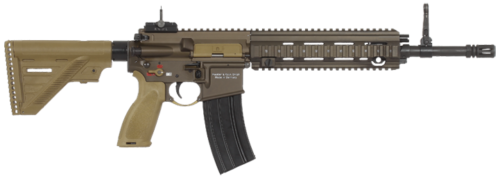
HK 416 and the U.S. Military
The HK 416 can actually trace its origins to a request from the early 2000’s request by U.S. Special Operations Command for a more reliable AR-15/M4 better suited to their most unusual mission parameters. Heckler & Koch accepted the challenge and the HK 416 was born.
Prior to the jump into the AR-15/M16 market, the German-based company had been riding high on the success of their MP-5 and MP-7 sub-machine guns and their very nice line of pistols. To a somewhat lesser degree of success, and a bit of controversy, they had success with their G36 rifles as well.
Since that time several U.S. Special Forces groups have fielded the HK 416 as a rifle option, but not quite as a formally accepted primary issue rifle. The U.S. Marines have examined the qualities of the HK 416 (under the M27 IAR designation) as a replacement for the sometimes maligned FN M249 SAW (Squad Automatic Weapon). In essence, the Marines have found the added maintenance, much greater weight, and larger configuration of the SAW to be too burdensome and lacking in accuracy requirements during recent conflicts.
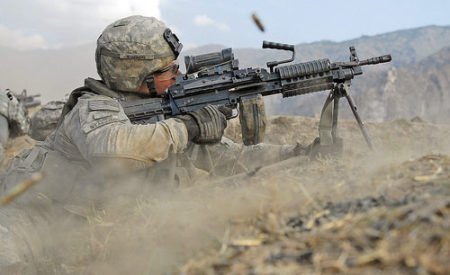
In fact, a 2002 report entitled “Lessons Learned in Afghanistan” released by the Natick Soldier Center (an Army testing center), reported the following disheartening statistics on the M249:
- 54% of SAW gunners had trouble maintaining their firearms
- 30% of SAW gunners reported the weapon rusted easily
- Some reported ammunition boxes rattled and fell off their gear
- 80% of SAW gunners said they were pleased with accuracy and lethality, but
- Only 64% of SAW gunners were “confident in their weapon.”
A 2006 Center for Naval Analyses report from Iraq found most SAW gunners were pleased with their weapon’s reliability, but nearly half preferred the soft-cased 100-round feed boxes over the larger 200-round boxes. Nearly half of the SAW gunners reported the weapon as being too heavy for its intended use. However, once again the SAW gunners reported the highest level of dissatisfaction with weapon maintainability (30%) of other infantry weapons, and the highest level of stoppages (30%). In fact, only 65% of SAW gunners were confident the SAW would perform without a stoppage, and 35% needed their SAW repaired while in theater.
Instead, the Marines seem to be willing to sacrifice the 200-round belt-fed capacity of the M249, for the lighter-weight, and much more accurate HK 416 (M27 IAR). It seems the Marines have found more accurate suppressive fire (the typical use of automatic firearms), is more important than the number of rounds being sent towards the enemy. A lighter weight, more mobile weapon system does have important benefits to the shooter and their squad. Magazines become interchangeable with standard riflemen in the unit, and if a larger capacity is desired there are 40, 60 and 100-round magazines readily available on the market.
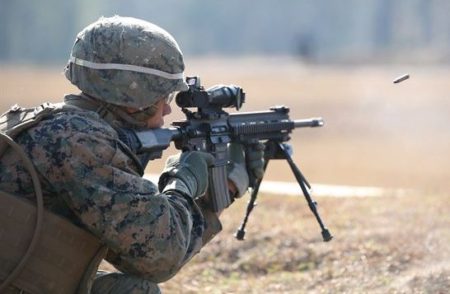
Heckler & Koch 416
The HK 416 comes in several configurations with the A5 being the latest development. However, the M27 IAR is based upon an earlier model. The A5 was actually submitted as a replacement for the M4, not as a squad automatic weapon. The most noticeable changes with the A5 compared to its previous versions include an improved and tool-less gas regulator for suppressor use, a redesigned lower receiver with completely ambidextrous operation, and optimized magazine compatibility. The A5 also received numerous technical improvements to maximize the operator safety, reliability, ammunition compatibility and durability under real operating conditions.
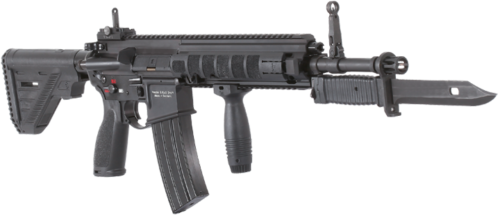
Previous HK 416 versions were much more limited in magazine selection, often only feeding standard USGI aluminum magazines or HK magazines. This was a major complaint by line soldiers and the civilian market as well (using the civilian version MR556A1). The widespread move to polymer magazines has been full-blown for a decade now, and the benefits of polymer magazines have been proven through military deployments and civilian torture tests. The A5’s design improvements now allow a much broader use of both aluminum and polymer magazines, a significant improvement in versatility from previous models.
The HK 416 gas-piston operating system is arguably one of the best on the market. The piston parts of the HK 416 are beefed up to withstand the harshest use in the most unforgiving terrains. In fact, the larger and heavier piston parts required HK to raise the height of the upper receiver’s top rail to accommodate the larger components.
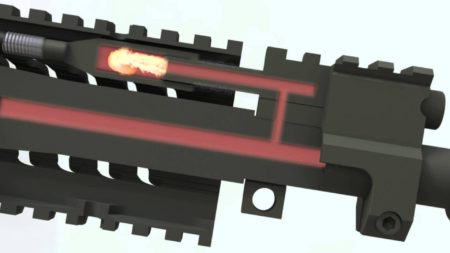
Gas-piston designs have been heralded as superior than traditional gas-impingement systems, as they do not expel hot gas from the cartridge discharge into the upper receiver. Instead, the hot expelled gas travels into the enclosed piston chamber where the pressure pushes a piston backward to unlock and open the bolt. This creates a very dependable action, allowing the discharged case to be ejected and a new cartridge chambered. Many sources herald the gas piston as being superior to the original gas impingement system, but the strongest arguments focus on the cleanliness after shooting, and the fact the gas piston systems tend to run cooler.
In my opinion, both systems work as intended, and if you keep a gas impingement system properly lubed, it will run just fine. However, a piston system is indeed cleaner, and does not need the pesky gas rings on the bolt that can sometimes fail. In addition, if the shooter mounts a suppressor the gas piston system prevents excessive heat, powder, and debris from being blown back into the face of the shooter. This is a huge benefit for suppressed shooting.
Unlike traditional AR-15/M16 designs, the HK 416 uses a captured firing pin, removing the cotter key firing pin retainer. This is another way the HK 416 reduces overall maintenance needs. HK also added a firing pin block. The design has a lever with hook on one end to lock the firing pin in place. The hook latches to the firing pin until the hammer falls, preventing slight firing pin marks or slam-fires when new rounds are chambered, like traditional AR-15/M16 designs. As the HK 416 fires, the hammer moves towards the firing pin and pushes the lever up, releasing the hook to allow the firing pin to move forward to discharge the cartridge. Using this system, the firing pin is locked until the trigger is pulled.
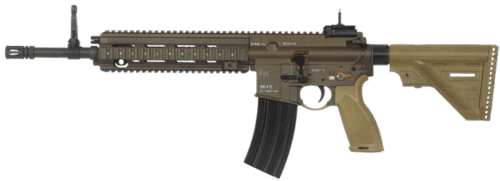
The HK 416 safety lever can be moved into the safe position even when the hammer is in the forward position. This is another advancement over the traditional AR-15/M16 design that required the rifle to be cocked before the safety could be engaged. The fire control symbols use international symbols rather than traditional Fire/Safe symbols.
One of the biggest complaints against the HK 416, besides its much larger price tag, is the elongated front side of the magazine well causing several very popular polymer magazines not to fit. The HK 416A5 has mostly corrected this problem, but is not widely used by the U.S. military yet. US STANAG metal magazines have had no issues, and these are the most widely used in the military, but the use of Magpul magazines and others have been widely reported from a variety of forces in oversees combat missions.
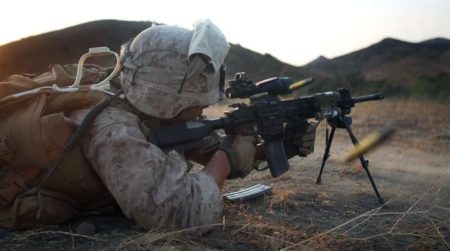
The HK 416 has received such high acclaim that recently France contracted with HK to change their standard military rifle to the HK 416 from their own FAMAS. Considering Germany itself has been a little skeptical of the G36, its current standard issue rifle, the HK 416 may become the standard issue rifle for the two largest militaries on the European continent. Here’s an impressive list of militaries already using the HK 416:
- Australia – Special Forces
- Brazil – Special Forces (military and police)
- France – new Standard issue Infantry rifle
- Germany – Special Forces and GSG-9
- Ireland – Rangers and Special Response (police)
- Italy – Navy commandos, 9th Parachute Regiment, GIS (special police)
- Japan – Special Forces
- Jordan – Special Operations Command
- Malaysia – Navy Special Operations, Anti-Terror Police
- Netherlands – Marine and Army Commandos, Military Police
- Norway – Standard issue rifle
- Poland – Special Forces, Police
- Philippines – Marine Force Recon
- Slovakia – Special Forces
- South Korea – Navy Special Warfare, National Police SWAT
- Turkey – Special Forces, Police Special Operations
- United Kingdom – Several police forces
- United States – Special Operations, NASA Emergency Response, FBI HRT, LAPD Metro Division, U.S. Marine Corps.
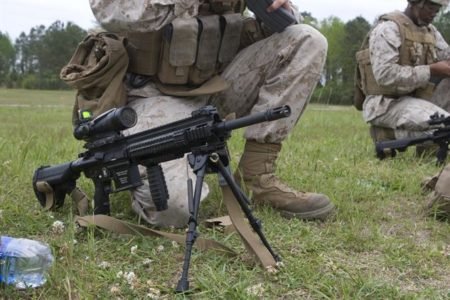
HK 416 Features
- Modified tool-less gas regulator for suppressor use
- Free-floating barrel
- Safety/Fire selector lever can be set to safe when hammer is cocked or uncocked
- Over the beach (OTB) capability
- Ambidextrous operating controls (bolt catch, Magazine release, safety/fire selector lever, and charging handle)
- “Winter” trigger guard for gloves and cold weather clothing
- Non-stop NATO-Stanag 4694 top rail
- Redesigned ergonomic pistol grip with storage compartment for field stripping tool
- Enlarged Bolt catch lever and protective barrier against accidental discharge
- “Slim line” Telescopic buttstock
- Optimized receiver geometry
- Modified receiver assembly interfaces and improved connections
- Receiver extension for stabilization drop test criteria
- Increased magazine compatibility in accordance with NATO-STANAG-DRAFT 4179 (M4/M16 Magazines)
- 40 mm Low velocity GLM/M320 interface.
HK 416 Specifications
- Caliber: 5.56mm/.223 caliber
- Upper Receiver Material: Billeted steel
- Lower Receiver Material: Billeted steel
- Barrel Material: Cold Hammer Forged alloy steel, unlined
- Operating System: Proprietary short-stroke gas piston, rotating bolt
- Rate of Fire: 850 rpm
- Overall Length: 31.38 inches (collapsed), 35.16 inches (extended)
- Barrel Length: 11.0″, 14.5″, 16.5″, or 20.0″
- Height: 9.45 inches
- Width: 2.91 inches
- Weight: 8.25 pounds (with magazine)
- Front Sight: Folding post
- Rear Sight: Rotating diopter
- Sight Radius: 16.93 inches
- Color: Black or Green/Brown
- Options: 20.0″ option has elongated hand guard with gas regulator window
- Options: 14.5″/16.5″/20.0″ modular interface for bayonet and flip-up front sight
- Options: 11.0″ hand guard with integrated flip-up front sight
- MSRP: $3000.00.
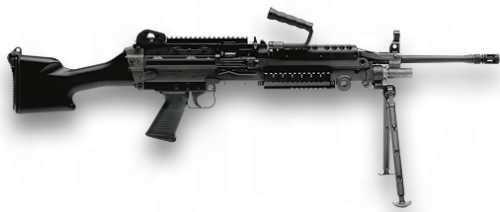
Comparison Between HK 416 and M249 SAW
To better understand some of the differences between the HK 416 and the more standard M4 we’ve produced the comparison table below.
As we can see from the table the HK 416 is smaller and nearly half the weight of the M249 SAW. The HK 416 is also about $1000 less expensive (firearm to firearm) than the M249. The HK 416 also has a slightly greater rate of fire. The M249 has a greater ammunition capacity when fielding the 100 or 200-round linked belt ammunition, but most Marines reported preferring the 100-round soft sided ammunition carrier over the 200-round versions.
The military currently outfits troops with either 20-round or 30-round magazines. However, greater capacity options are already on the market and could be added relatively easily. We have also seen a general allowance of troops using their own magazines in Afghanistan and Iraq, so a Marine could likely field a Surefire or Magpul 60-round magazine or the Surefire 100-round magazine or Beta magazine should they prefer greater capacity.
The benefit of using 30-round magazines though may outweigh the bulkiness of larger magazines. With good training a Marine can switch out 30-round magazines quickly and efficiently. In addition, by using 30-round magazines frequently the Squad Automatic Rifle operator can interchange with available magazines from any riflemen near them. Either way, one of the reasons the Marines are considering the HK 416 is to provide more accurate fire. In that regard the gunner may use a slower rate of fire, but actually place rounds much closer to the target.
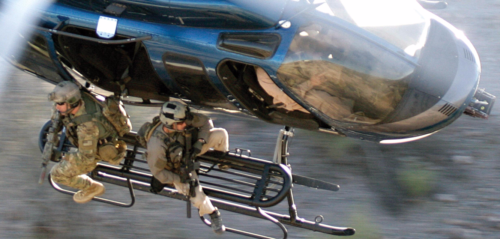
HK 416 and Law Enforcement
So how does all this talk about what the U.S. Marines or other military units choosing the HK 416 have anything to do with American law enforcement? Like many things in government, once one government entity approves something for use, many others will tag along as well. Some of this is just an ease of decision making, but when it comes to the military an agency can know that significant and well qualified arms specialists were involved in the decision making.
U.S. Special Operations, and the U.S. Marines already use the HK 416 on a limited scale. NASA Emergency Response, FBI HRT, and LAPD Metro Division are also well known users of the HK 416. Due to its high cost, the HK 416 may never reach into the hands of ordinary patrol officers, but a fiscally sound agency with a high profile/use SWAT Team could very much benefit from the HK 416.
As more military units and special operations units go to the HK 416, the price will likely go down as the rifle becomes more of a mainstay build, rather than a firearm for special forces. If this happens, I would expect many more police agencies to take advantage of HK excellence.
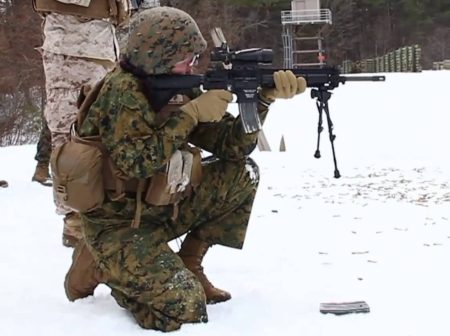
Final Thoughts
Heckler & Koch is one of the best gun manufacturers in the world. Their innovative designs and mastery of engineering and manufacturing principles have produced some of the finest firearms on the market. The HK 416 can trace its birth to a request from U.S. Special Operations to have a more reliable M4 for the toughest conditions a soldier can face. To date, Special Operations troops have used the HK 416 with remarkable success and praise.
The weight, and size reductions make the HK 416 a very appealing weapon system over the M249. Maintenance of the HK 416 is very similar to the M4’s already issued to Marines, and with a gas-piston system, the amount of carbon build-up and other debris should be greatly reduced allowing for a much quicker cleaning and maintenance routine.
The HK 416 is not cheap, but is actually less expensive than the M249 SAW. As budgets fluctuate from time to time, having a cheaper option allows for critical funds to be spent elsewhere to keep the fighting force modern and capable. Despite all the advantages of the HK 416 (M27 IAR) I don’t see the Marines or other U.S. forces switching to this option for their standard infantry rifle. Instead, I see the HK 416 remaining a Special Operations selection, and a squad automatic rifle selection.
Finally, the Marine Command appears to see the value in an automatic weapon system that provides more accurate fire on target, rather than more volume of fire. In this regard, the HK 416 appears better designed to meet that goal. When a Marine knows his weapon system is only feeding 30-rounds at a time, training doctrine should dictate shorter and more controlled bursts of fire. This would still provide the automatic suppressive fire desired, but can deliver those rounds in a much more accurate manner, which appears to be just what the Marine Command ordered.